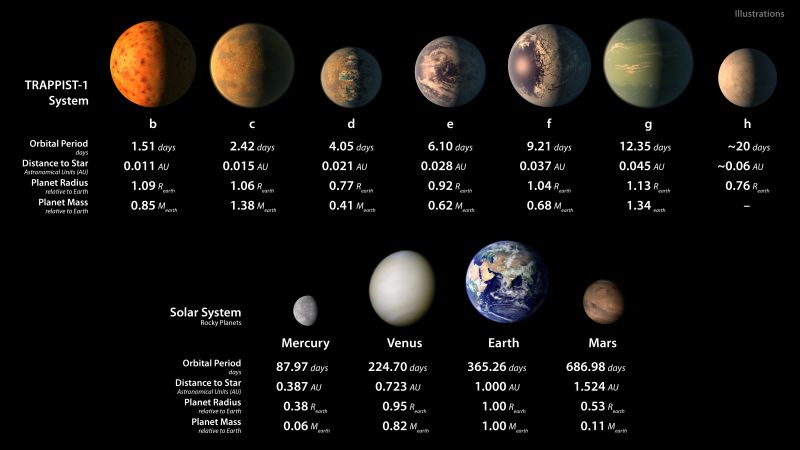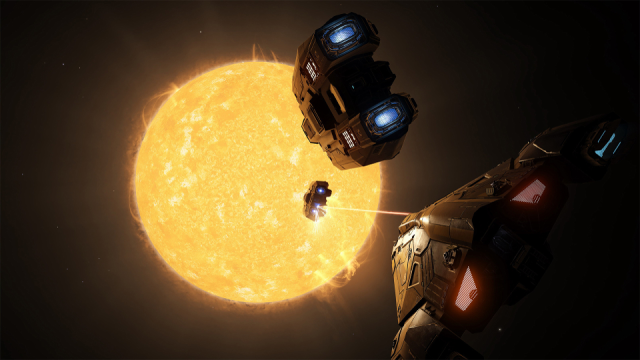NASA had some big news this past week. No, it wasn’t aliens. It was the next best thing: the discovery of seven new “Earth-sized exoplanets,” a few of which could be hospitable to life. Now, it turns out that Elite: Dangerous actually predicted the existence of the TRAPPIST-1 star system where they’re located.
Elite: Dangerous, the game you’re probably constantly hearing about but have perhaps been too intimidated to play, is a large-scale space trading simulator. Players explore and trade goods inside a 1:1 scale open world galaxy based on the real Milky Way, leading to any number of strange and uncanny experiences, like playing Grand Theft Auto in space.
But to generate its numerous star systems and other cosmic phenomena, the game’s Stellar Forge engine takes the total measured matter for our galaxy and allocates it between known objects and other, procedurally generated ones. Using some of the leftover “unaccounted mass,” the game, unprompted, created a star system very much like TRAPPIST-1.

Image: NASA/JPL-Caltech
CEO of Frontier Developments and the director Elite: Dangerous, David Braben, explained the anomaly in the game’s forums,
“The way Stellar Forge works is to use ‘available mass’ from which to generate systems — and because of this unaccounted mass, Stellar Forge has created a system with a Brown Dwarf in very nearly the same place — 39 light years away — this is only a little smaller than an M8 — and it even has seven terrestrial worlds around it — Core Sys Sector XU-P A5-0.
Interestingly the system that came out of Stellar Forge has a couple of moons, and a couple of co-orbiting binary pairs — these things would not (yet) be detected in the occlusion technique, as this is simply detecting the darkening of the stellar disc, but who knows, this might be possible.”
As a result of this collision between reality and simulation, Braben said the game will be updated with the data from the recent discovery to make Elite: Dangerous‘ version of the star system identical. It will even be officially named TRAPPIST-1 and added to the game in its 2.3 beta. “The great thing is it is only a small tweak!” wrote Braben.
NASA’s original reveal of TRAPPIST-1 and the planets orbiting it was big news in part because of its implications in the ongoing search for extraterrestrial life. “Finding several potential habitable planets per star is great news for our search for life,” the Director of the Carl Sagan Institute at Cornell University told Gizmodo last week.
But while the search for alien life in the cosmos continues, it’s already been discovered in Elite: Dangerous. An Xbox One player discovered a giant, magnolia-looking UFO in the game earlier this year. Despite already being out for a couple years, the first sighting didn’t occur until last month, a testament to the game’s methodical approximation of real-space and the slow-burn satisfaction of encountering its hidden wonders.
Only time will tell if Elite: Dangerous’ alien life is as predictive of its original approximation of the TRAPPIST-1 system.

Comments
5 responses to “The Newly Discovered TRAPPIST-1 Star System Was Hiding In Elite: Dangerous All Along”
They’re good with this. They’ve been tweaking specific solar systems and the engine regularly.
One minor thing though – the alien encounters weren’t in the game for two years and then discovered last month – Frontier are releasing new content constantly as part of the ongoing story. Which is cool. Although I’ve still not seen the space flower myself yet. Visited 2 of the crash sites so far discovered. They’re a bit spooky.
It’s a lonely game (for explorers at least), but I’m amazed at the depth. I’m only new to the game (a month or two) and I already have my name on quite a few newly explored systems not that far from the populated areas.
Less lonely if you join expeditions, or you head to some of the destinations that cmdrs are currently lurking at like the alien ruins sites. Upcoming expeditions are marked on the EDSM site. https://www.edsm.net/en/expeditions and you can join the EDEX group on Discord for some company in the black. Meeting up on rocky moons thousands of ly from the bubble is fun.
Also, get those passenger sightseeing missions for the exploration rank before they get nerfed in 2.3 🙂
I’m on most evenings. Feel free to msg me in game – happy to give you some pointers or run escort if you’re entering or leaving the Bubble and you’ve rigged your ship for extreme range (shieldless exploring. it’s hardcore…)
I still have shield, albeit a small one. My Cobra and I are getting 24ly per jump currently, but am busily hoarding cash for far juicier FSD equipped ships…
Cobra’s a lovely all-rounder, but yeah the jump range is a little short. Here’s about the max range you can get and still have a shield.
http://bit.ly/2lppGp7
It’s great for sightseeing within a thousand ly of the bubble. Hauler and Type 6 are long-legged, although the Type-6 runs pretty warm and scooping’s a tentative business in a Type 6.
Diamondback Explorer’s an excellent choice after the Cobra, then AspX and of course the almighty “Exploraconda” – my fully engineered Anaconda’s got a 49ly range when I’m not lugging cargo, and I always carry a few limpets in case I find a haul of escape pods.
CMDR Trikeabout – Master, Entrepreneur, Elite, Petty Officer, Baron. 🙂